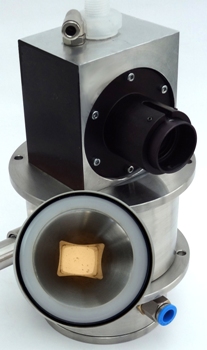Oct 18 2013
There are exceedingly strict cleanliness guidelines for components in sectors such as the automobile industry. And yet monitoring of the process for parts purification has been inadequate to date. Fraunhofer researchers have developed a sensor-based measurement system that is integrated directly in the cleaning system, where it registers and analyzes particles caught up in the cleansing fluid. The researchers are presenting their now-marketable innovation at this year’s parts2clean.
 View into the analysis sieve: The sensor system “PuriCheck” can be connected to all standard cleaning systems. © Fraunhofer IPA
View into the analysis sieve: The sensor system “PuriCheck” can be connected to all standard cleaning systems. © Fraunhofer IPA
For components emerging from processing, the first order of business is: off to the showers! Oftentimes, multiple layers of impurities have become deposited on the surface, such as lubricant residues or filings. If these particles are not removed, they can affect the quality and functioning of the products in which they are used later on. The cleanliness guidelines for sectors such as the automobile industry have been considerably stiffened in recent years. The problem with this: to date, there hasn’t been a satisfactory method with which to monitor the purification process, as there are no suitable measurement systems on the market that can be directly built into industrial cleaning systems. The effectiveness of cleansing procedures is checked through random sampling of individual components emerging from each batch. This process is a laborious one, however: to perform these checks, employees must manually wash away any residual impurities by hand in the laboratory, capture the particles rinsed away in a filter for analysis, and then analyze the results under a microscope. This method is too time-consuming and labor-intensive to permit a statistically relevant testing frequency.
Researchers at the Fraunhofer Institute for Manufacturing Engineering and Automation IPA have now developed “PuriCheck” - a system that will make future cleanliness controls simpler and much more efficient. “This is a sensor system that can be connected to all standard cleaning systems, where it will monitor rinsing baths, for instance,” explains Dr. Markus Rochowicz, group manager for contamination control at Fraunhofer IPA. The system consists of an analysis sieve with a variable mesh width, along with integrated camera technology and software for image analysis. The analysis sieve is installed in the system, directly in the flow of the rinsing bath, trapping any particles larger than the chosen mesh width. The built-in camera records the surface of the sieve at freely chosen measurement intervals and passes the images along to the software. The software, in turn, analyzes the size and quantity of particles and generates the results in tabular form. Alongside monitoring of purification processes, “PuriCheck” is also an asset to cleanliness analysis of components: because the individual work steps no longer need to be carried out by hand and are now automatic instead, the sample size can be increased considerably.
Optical counters of particles in fluid have been on the market for some time – but thus far, equipment that works superbly under laboratory conditions is still not up to the task in the rough and tumble of the day-to-day production environment. “The systems currently available are very sensitive to air bubbles or oil drops in the water. And that can significantly falsify the measurement result,” Rochowicz points out. Using the IPA solution, air bubbles or oil drops can simply slip through the analytical sieve; this keeps them from erroneously being identified as particles.
The functional principle of “PuriCheck” has already proven itself in multiple pilot applications. The Researchers have brought Nägele Mechanik – a medium-sized company with a long history of project experience involving particles – on board for the step to a marketable product. The main focus in final developments is upon optimizing the system in terms of user-friendliness and robustness. With this in mind, for instance, the project partners have built in an easy-to-operate mechanism that can be used to rinse away any particles trapped in the analytical sieve. This prevents overloading or clogging and ensures smooth measurement behavior throughout the purification process. The project partners will be presenting this ready-to-use system at parts2clean, in Hall 6, Booth 6214/6313.